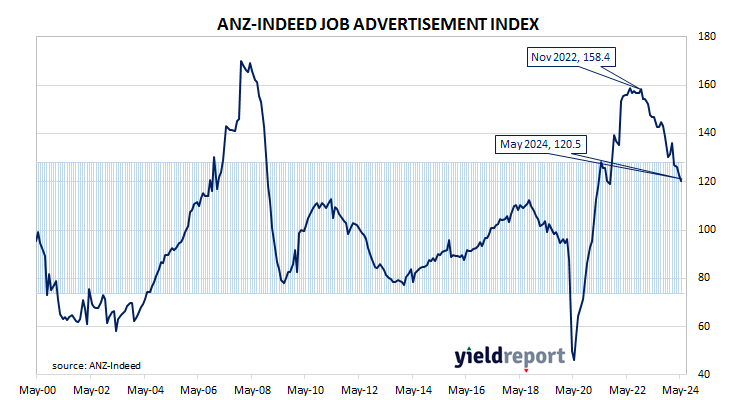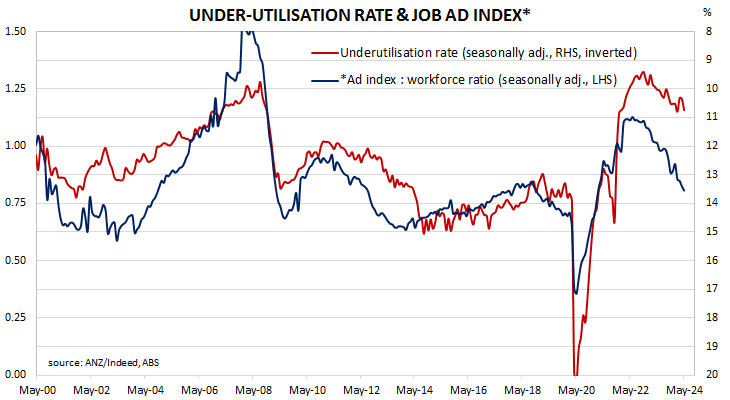Summary: Job ads down 2.1% in May; 18.1% lower than May 2023; ANZ labour market cooling but only gradually; ACGB yields fall; rate-cut expectations firm; Westpac: supports expectation of further gradual easing in labour market; ad index-to-workforce ratio slips.
From mid-2017 onwards, year-on-year growth rates in the total number of Australian job advertisements consistently exceeded 10%. That was until mid-2018 when the annual growth rate fell back markedly. 2019 was notable for its reduced employment advertising and this trend continued into the first quarter of 2020. Advertising then plunged in April and May of 2020 as pandemic restrictions took effect but recovered quite quickly, reaching historically-high levels in 2022.
According to the latest reading of the ANZ-Indeed Job Ads Index, total job advertisements in May decreased by 2.1% on a seasonally adjusted basis. The index fell from 123.0 in April after revisions to 120.5, with the loss following falls of 2.3% in April and 0.7% in March. On a 12-month basis, total job advertisements were 18.1% lower than in May 2023, down from April’s downwardly-revised figure of -16.2%. (Note: large revisions to early 2024 data.)
“The revised ANZ-Indeed Australian Job Ads series shows a softening over 2024, with an 8.2% fall since the end of last year,” said ANZ economist Madeline Dunk. “Other data also show the labour market is cooling but only gradually.”
Commonwealth Government bond yields fell modestly on the day with the exception of ultra-long yields which caught up from Friday’s lag. By the close of business, the 3-year ACGB yield had lost 2bps to 3.76%, the 10-year yield had slipped 1bp to 4.11% while the 20-year yield finished 7bps lower at 4.44%.
Expectations regarding rate cuts in the next twelve months firmed by the end of the day. In the cash futures market, contracts implied the cash rate would remain close to the current rate for the next few months and average 4.315% through June, 4.31% in July and 4.315% in August. However, November contracts implied 4.24%, February 2025 contracts implied 4.145% while May 2025 contracts implied 4.09%, 23bps less than the current cash rate.
“The continued pull-back in job ads supports our expectation of a further gradual easing in labour market conditions over the remainder of 2024,” said Westpac economist Jameson Coombs.
The inverse relationship between job advertisements and the unemployment rate has been quite strong (see below chart), although ANZ themselves called the relationship between the two series into question in early 2019.
A higher job advertisement index as a proportion of the labour force is suggestive of lower unemployment rates in the near future while a lower ratio suggests higher unemployment rates will follow. May’s ad index-to-workforce ratio declined from 0.82 after revisions to 0.81.
In 2008/2009, advertisements plummeted and Australia’s unemployment rate jumped from 4% to nearly 6% over a period of 15 months. When a more dramatic fall in advertisements took place in April 2020, the unemployment rate responded much more quickly.



